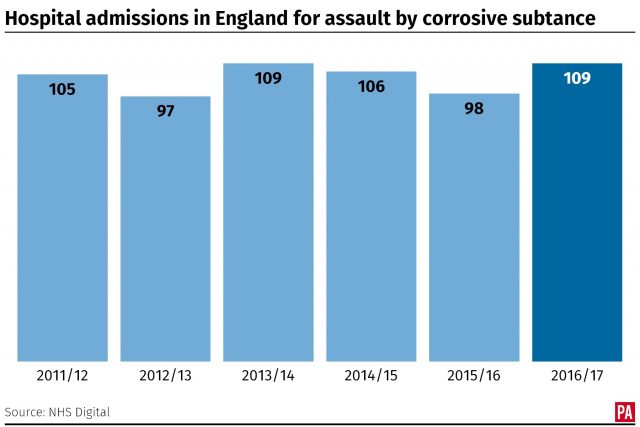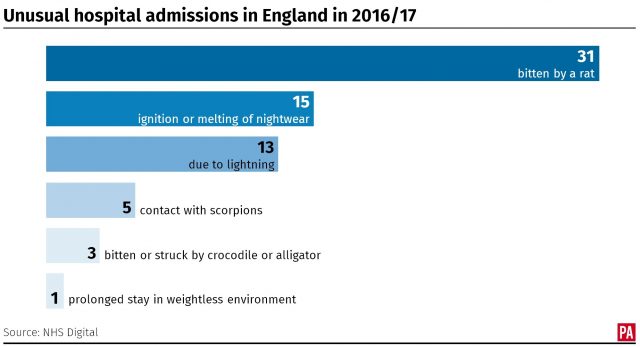New figures show hundreds of hospital admissions due to acid attacks in England over the last six years.
NHS Digital data shows that since 2011/12 there have been 624 admissions because of an “assault by corrosive substance”.
In 2016/17, there were 109 hospital admissions due to such attacks.

Victims can be left blind or severely disfigured after being doused in corrosive substances.
In August, health officials issued guidance on how witnesses can help victims of acid attacks, saying that the minutes after an assault are critical in helping those affected.
The new Report, Remove, Rinse guidance from NHS England urges witnesses or victims to report the attack by calling 999, carefully remove contaminated clothing, and immediately rinse skin in running water.
.@NHSDigital stats reveal how admissions in England there were for patients being "bitten or struck by a crocodile or alligator"
— Ella Pickover (@ellapickoverpa) October 3, 2017
More than 400 acid or corrosive substance attacks were carried out in the six months up to April this year, according to figures from 39 police forces in England and Wales.
The NHS Digital figures also show that in 2016/17 there were 386 hospital admissions after a pedestrian was injured in collision with a bicycle.
And the number of pedestrians admitted to English hospitals after being struck by motor vehicles – including cars, lorries and motor bikes – was 6,948 last year.

Last week, Department for Transport data showed that three pedestrians died after being hit by bicycles in 2016. A further 243 were killed by cars and 55 by heavy goods vehicles.
The DfT announced a review into laws regarding cyclists after the sentencing of a man who killed mother-of-two Kim Briggs, 44, as he rode a fixed-wheel track bike with no front brakes.
Charlie Alliston, 20, was handed an 18-month jail term after being found guilty of causing bodily harm by ”wanton and furious driving”, a crime under the 1861 Offences Against the Person Act which carries a maximum sentence of two years in jail.
Figs also show hundreds of admissions for acid attacks over the last 6 years. News comes as Home Sec pledges ban on sale of acid to children
— Ella Pickover (@ellapickoverpa) October 3, 2017
Overall, the new NHS Digital data hospital inpatient, day case and adult critical care episodes in England showed a big rise in “episodes” of patient care – or finished consultant episodes.
In 2016-17, there were 19.7 million finished consultant episodes in English hospitals – 33.4% rise from 10 years ago.
The figures also show some of the more unusual hospital cases including rat bites, lightning strikes and contact with scorpions.
In 2016/17 there were:
:: 13 hospital admissions due to lightning;
:: Three admissions for people being “bitten or struck by a crocodile or alligator”;
:: Five admissions for “contact with scorpions”;
:: 31 hospital admissions for people bitten by a rat;
